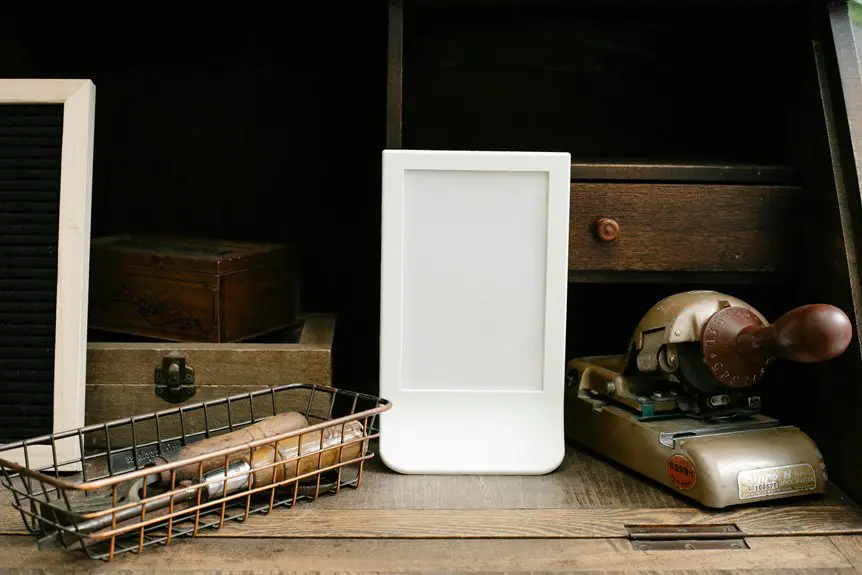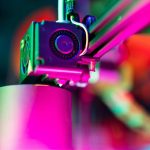If you're setting up a workshop home office, choosing the right printer is crucial, especially when it comes to dust resistance. A dust-resistant printer can protect your investment and ensure reliable performance. You'll want to look for specific features that keep dust at bay, but not all models are created equal. Let's explore some top options that could fit your needs and help maintain a clean workspace.
Table of Contents
Key Takeaways
- Look for printers with a sealed design to prevent dust infiltration and ensure smooth operation in workshop environments.
- Recommended models include Brother MFC-L3770CDW and Canon imageCLASS MF445dw, known for their durability and dust resistance.
- Consider compact options like HP LaserJet Pro M15w for limited space without compromising dust protection.
- Regular maintenance, including monthly cleaning and using protective covers, helps maintain dust resistance and printer performance.
- Dust-resistant printers enhance longevity, reduce mechanical failures, and improve productivity in home office settings.
Understanding Dust Resistance in Printers
When choosing a printer for your home office, understanding dust resistance is crucial. Dust can accumulate inside printers, causing jams, misprints, and even permanent damage.
If you're working in a workshop environment, the risk increases, making dust resistance even more important. Look for printers with sealed mechanisms that prevent dust from entering sensitive areas.
Also, consider models with easy-to-clean surfaces, which help you maintain the printer's performance over time. You want a device that can withstand the challenges of your workspace without frequent breakdowns or maintenance issues.
Prioritizing dust resistance not only extends your printer's lifespan but also ensures consistent print quality, allowing you to focus on your work without worry.
Features to Look for in a Dust-Resistant Printer
When choosing a dust-resistant printer, you should focus on its sealed design and filter efficiency ratings.
A sealed design helps keep dust out, ensuring your printer runs smoothly over time.
Meanwhile, high filter efficiency ratings can significantly reduce the amount of dust that gets inside, protecting your investment.
Sealed Design Benefits
Although many printers promise durability, a sealed design is essential for ensuring dust resistance in your home office.
With a sealed printer, you'll reduce the risk of dust particles infiltrating internal components, which can lead to malfunctions and reduced print quality. This design often features tightly fitted panels and protective covers, minimizing exposure to the workshop environment.
Additionally, sealed designs usually mean less frequent maintenance, saving you time and hassle.
You'll appreciate the peace of mind knowing your printer can withstand the dust and debris common in a workshop setting.
When choosing a printer, look for models specifically marketed as dust-resistant with a robust sealed design to keep your print jobs running smoothly and efficiently.
Filter Efficiency Ratings
A sealed design is just one aspect of ensuring your printer can handle the dust in your home office.
You should also pay close attention to filter efficiency ratings. These ratings indicate how well a printer can trap dust and other particles, keeping your machine clean and functioning optimally.
Look for printers with HEPA filters, as they're designed to capture 99.97% of particles as small as 0.3 microns. Additionally, consider printers with multi-stage filtration systems, which can enhance dust prevention.
Regularly check and replace filters according to the manufacturer's recommendations to maintain efficiency.
Top Dust-Resistant Printer Models for Home Workshops
For home workshops that often contend with dust and debris, choosing the right printer is crucial. You'll want a model that offers solid protection against particles while maintaining performance.
The Brother MFC-L3770CDW is a reliable choice, featuring a sealed design that helps keep dust at bay. If you're looking for a compact option, check out the HP LaserJet Pro M15w; it's small yet efficient, with a dust-resistant casing.
Another great pick is the Epson EcoTank ET-2720, which boasts an enclosed ink system that minimizes exposure to dust.
Lastly, the Canon imageCLASS MF445dw offers robust features and a sturdy body designed to withstand workshop conditions. These printers can help you maintain productivity in a dusty environment.
Maintenance Tips for Keeping Your Printer Dust-Free
To keep your printer dust-free, it's essential to establish a regular cleaning schedule.
Using protective covers when the printer isn't in use can also make a significant difference.
Plus, choosing the right spot for your printer helps minimize dust accumulation in the first place.
Regular Cleaning Schedule
Establishing a regular cleaning schedule is essential for keeping your printer dust-free and operating smoothly. Aim to clean your printer at least once a month, or more frequently if your workspace collects dust quickly.
Start by unplugging the printer and using a soft, lint-free cloth to wipe down the exterior. For the interior, gently use a can of compressed air to blow away dust from vents and components.
Don't forget to check and clean the paper feed and cartridges, as dust can affect print quality. Keeping the area around your printer tidy will also help reduce dust accumulation.
Protective Covers Usage
Using a protective cover is one of the simplest ways to keep your printer dust-free when it's not in use. These covers act as a barrier against dust, dirt, and other particles that can settle on your printer and interfere with its performance.
Choose a cover that fits snugly over your printer, ensuring it's made from breathable material to prevent moisture buildup.
When you finish printing, simply slip the cover on to provide instant protection. Don't forget to clean the cover regularly to avoid transferring dust back onto your printer.
Additionally, keep the area around your printer clean and tidy, as this will reduce the amount of dust that can accumulate.
Optimal Placement Strategies
While you might think any flat surface will do for your printer, choosing the right placement can significantly reduce dust accumulation.
Position your printer away from windows and doors to avoid dust carried in by drafts. Consider elevating it on a dedicated shelf or table instead of placing it directly on the floor, as this helps minimize debris from foot traffic.
Additionally, keep it in a low-traffic area of your home office, reducing the chances of dust settling due to movement. Ensure that there's enough space around the printer for airflow; this not only helps with cooling but also prevents dust from gathering.
Regularly check and clean the area around your printer to maintain a dust-free environment.
Benefits of Using a Dust-Resistant Printer
When you choose a dust-resistant printer for your home office, you're investing in longevity and performance.
These printers are designed to withstand the grit and grime that can accumulate in workshop environments, ensuring they run smoothly for years. By minimizing dust exposure, you'll reduce the risk of mechanical failures and costly repairs.
This reliability translates to less downtime, so you can focus on your work instead of dealing with equipment issues. Additionally, dust-resistant printers often feature easier maintenance, allowing you to spend less time cleaning and more time being productive.
Ultimately, investing in a dust-resistant model means you're prioritizing efficiency and quality in your workspace, leading to better results in your projects.
Alternative Solutions for Dust Management in Your Workspace
To maintain a dust-free workspace, consider implementing a variety of effective dust management strategies.
First, invest in air purifiers with HEPA filters to trap fine dust particles circulating in the air. Regularly vacuum your workspace with a vacuum equipped with a HEPA filter to minimize dust buildup on surfaces.
Use damp cloths for cleaning, as they'll capture dust instead of spreading it around. You might also want to seal any gaps in windows and doors to prevent outside dust from entering.
Additionally, consider using bins with lids to store materials and tools, reducing dust exposure.
Lastly, establish a routine for cleaning and decluttering to keep your workspace tidy and dust-free. A proactive approach will significantly enhance your working environment.
Frequently Asked Questions
How Much Do Dust-Resistant Printers Typically Cost?
Dust-resistant printers usually range from $150 to $1,000, depending on features and brand. You'll find various options that suit your budget, so it's worth shopping around to find the best fit for your needs.
Can I Use Non-Dust-Resistant Printers in Workshops?
You can use non-dust-resistant printers in workshops, but they may suffer from dust damage. Regular cleaning and maintenance will help, but investing in a dust-resistant option could save you hassle and money in the long run.
What Is the Lifespan of a Dust-Resistant Printer?
The lifespan of a dust-resistant printer typically ranges from five to seven years, depending on usage and maintenance. Regular cleaning and proper care can extend its longevity, ensuring reliable performance throughout its life.
Are Inkjet or Laser Printers Better for Dusty Environments?
In dusty environments, laser printers often outperform inkjet printers. They handle debris better and avoid ink clogging, ensuring consistent print quality. You'll find less maintenance and longer-lasting performance with a laser printer in those conditions.
Do Dust-Resistant Printers Require Special Ink or Toner?
Dust-resistant printers typically don't require special ink or toner; they use standard supplies. However, it's best to check the manufacturer's specifications, as some models may have unique requirements to ensure optimal performance in challenging environments.




